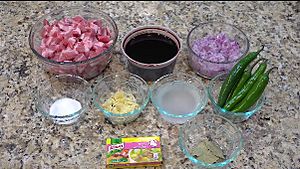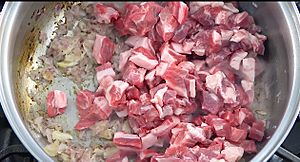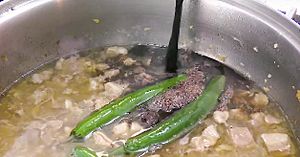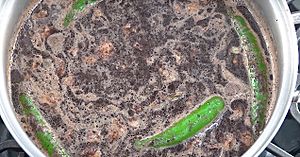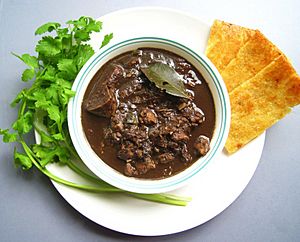Dinuguan facts for kids
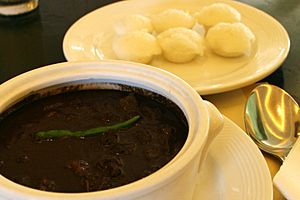
A bowl of dinuguan and a plate of puto
|
|
| Alternative names | Pork blood stew, blood pudding stew |
|---|---|
| Type | Stew |
| Course | Main course |
| Place of origin | Philippines |
| Serving temperature | Hot |
| Main ingredients | Pork offal, pig's blood, vinegar, garlic, siling haba |
Dinuguan is a popular Filipino stew that might sound a bit unusual! It's usually made with pork meat and/or pork organs like lungs, kidneys, and intestines. These ingredients are cooked slowly in a rich, dark, and spicy sauce. The special part of the sauce is that it's made with pig blood, garlic, chili peppers (often siling haba), and vinegar. It's a savory dish, meaning it has a rich, meaty flavor.
Contents
What's in a Name?
The name dinuguan comes from the Tagalog word "dugo," which means "blood." So, "dinuguan" basically means "cooked with blood." In English, people sometimes call it pork blood stew or blood pudding stew.
This dish has many different names depending on where you are in the Philippines. For example, it's called sinugaok in Batangas, zinagan in Ibanag, and tid-tad in Kapampangan. In Ilocano, it's dinardaraan, and in Cebuano, it's dugo-dugo. Some people even playfully call it "chocolate meat" because of its dark color!
Dinuguan is also enjoyed in the Mariana Islands, where it's known as Fritada. It's thought that Filipino immigrants brought this tasty dish to the islands.
What is it Like?
Dinuguan can be compared to some European dishes like blood sausage or black pudding, but it's served as a saucy stew. It's a bit like a hearty, dark soup.
While it often uses pork organs, dinuguan can also be made with just regular cuts of pork meat. When made this way in Batangas, it's called sinungaok. You can even find versions made with beef or chicken, like dinuguang manok (chicken dinuguan).
This stew is usually eaten with white rice or a Filipino rice cake called puto. In Northern Luzon, some versions like dinardaraan are drier and topped with crispy deep-fried pork cracklings.
The pig's blood is a key ingredient, and it's used in many other Asian dishes too. Sometimes it's used as solid pieces, and sometimes, like in dinuguan, it's mixed into the broth to make it rich and thick.
It's important to know that some people choose not to eat this dish because of their beliefs or dietary rules.
How to Make It
| Step 1: Gather Ingredients | Step 2: Sauté the Pork | Step 3: Add Liquids and Spices | Step 4: Simmer Until Thick |
|---|---|---|---|
Serving Suggestions
| With Puto | With Tuyo | Paleo Version |
|---|---|---|

Dinuguan is often served with puto (Filipino rice cake).
|
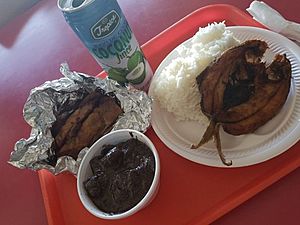
It can also be eaten with tuyo (fried dried fish).
|
Regional Variations
There are many interesting ways dinuguan is made across the Philippines:
- In Aklan, they call it dinuguan sa batwan and add the sour batwan fruit.
- In Bulacan, serkele is a similar dish, but it uses beef organs and is sour, sometimes without pig's blood.
- In Marinduque, kari-kari is cooked until it's almost dry before the pork blood is added.
- In Bicol, tinutungang dinuguan includes coconut milk and chilies, giving it a creamy and spicy flavor.
- In the Ilocos Region, you might find crispy dinuguan made with slices of bagnet (crispy pork belly).
- In Pampanga, dinuguang puti (white dinuguan) is unique because the blood is torn into pieces by hand after it thickens, making it look different from the usual dark stew.
- In Pangasinan, baguisen uses kamias (a sour fruit) to make it tangy.
- In Quezon Province, pirihil is a dinuguan made with chicken gizzard, heart, and liver.
- In Visayas, paklay is a drier version made with goat blood and intestines.
- In Zamboanga and Cavite, the "Chavacano-style dinuguan" uses tuba (sugar cane) vinegar and crushed oregano leaves.
See also
 In Spanish: Dinuguan para niños
In Spanish: Dinuguan para niños


